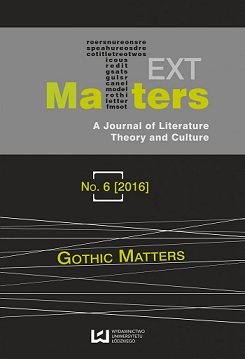Nick Joaquin’s Cándido’s Apocalypse: Re-imagining the Gothic in a Postcolonial Philippines
DOI:
https://doi.org/10.1515/texmat-2016-0007Abstract
Nick Joaquin, one of the Philippines’ pillars of literature in English, is regrettably known locally for his nostalgic take on the Hispanic aspect of Philippine culture. While Joaquin did spend a great deal of time creatively exploring the Philippines’ Hispanic past, he certainly did not do so simply because of nostalgia. As recent studies have shown, Joaquin’s classic techniques that often echo the Hispanic influence on Philippine culture may also be considered as a form of resistance against both the American neocolonial influence and the nativist brand of nationalism in the 1950s and 1960s. Despite the emergence of Gothic criticism in postcolonial writing, Joaquin’s works have rarely received the attention they deserve in this critical area.
In this context, this paper explores the idea of the Gothic in Joaquin’s writing and how it relates to Joaquin being the “most original voice in postcolonial Philippine writing.” In 1972, the University of Queensland Press featured Joaquin’s works in its Asian and Pacific writing series. This “new” collection, Tropical Gothic (1972), contained his significant early works published in Prose and Poems (1952) plus his novellas. This collection’s title highlights a specific aspect of Joaquin’s writing, that of his propensity to use Gothic tropes such as the blending of the real and the fantastic, or the tragic and the comic, as shown in most of the stories in the collection. In particular, I examine how his novella (Cándido’s Apocalypse) interrogates the neurosis of the nation—a disconnection from the past and its repercussions on the present/future of the Philippines.
Downloads
References
Blanco, John. “Baroque Modernity and the Colonial World: Aesthetics and Catastrophe in Nick Joaquin’s A Portrait of the Artist as Filipino.” Kritika Kultura 4 (2014): 5–35. Web. 1 Feb. 2014.
Google Scholar
Bernad, Miguel. Bamboo and the Greenwood Tree. Manila: Bookmark, 1961. Print.
Google Scholar
Casper, Leonard. “Beyond the Mind’s Mirage: Tales by Joaquin and Cordero-Fernando.” Philippine Studies 31.1 (1983): 87–93. Print.
Google Scholar
Furay, H. B. “The Stories of Nick Joaquin.” Philippine Studies 1.2 (1953): 144–54. Print.
Google Scholar
Hidalgo, Cristina Pantoja. Fabulists and Chroniclers. Quezon City: U of the Philippines P, 2008. Print.
Google Scholar
Holden, Philip. “The ‘Postcolonial Gothic’: Absent Histories, Present Contexts.” Textual Practice 23.3 (2009): 353–72. Web. 10 Jan. 2014.
Google Scholar
Horner, Avril, and Sue Zlosnik. “Comic Gothic.” A New Companion to the Gothic. Ed. David Punter. Malden, MA: Wiley-Blackwell, 2012. 321–34. Print.
Google Scholar
Joaquin, Nick. “Cándido’s Apocalypse.” Tropical Gothic. St. Lucia, Qld.: U of Queensland P, 1972. 3–56. Print.
Google Scholar
Joaquin, Nick. “Nick Joaquin with J. F. Lacaba.” Conversations with Filipino Writers. By Roger J. Bresnahan. Manila: New Day, 1990. 63–76. Print.
Google Scholar
Joaquin, Nick. “The Way We Were.” Writers and Their Milieu: An Oral History of Second Generation Writers in English Part II. Ed. Edilberto N. Alegre and Doreen Fernandez. Manila: De La Salle UP, 1987. 1–9. Print.
Google Scholar
Kahir, Tabish. The Gothic, Postcolonialism and Otherness: Ghosts from Elsewhere. Basingstoke: Palgrave Macmillan, 2009. Print.
Google Scholar
Melencio, Gloria Esguerra. “Asocena: History of Dog Meat-Eating in the Philippines.” About Philippines. Web. 20 Feb. 2014.
Google Scholar
Mojares, Resil. “Joaquin, Nick: Biography.” Ramon Magsaysay Award Foundation. Web. 20 Feb. 2014.
Google Scholar
Mojares, Resil. Waiting for Mariang Makiling: Essays in Philippine Cultural History. Quezon City: Ateneo de Manila UP, 2002. Print.
Google Scholar
Rydell, Robert W. All the World’s a Fair: Visions of Empire at American International Expositions, 1876–1916. Chicago: U of Chicago P, 1984. Print.
Google Scholar
San Juan, Epifanio. Subversions of Desire: Prolegomena to Nick Joaquin. Honolulu, HI: U of Hawaii P, 1988. Print.
Google Scholar
Sharrad, Paul. “Echoes and Antecedents: Nick Joaquin’s Tropical Gothic.” World Literature Written in English 20.2 (1981): 355–66. Web. 28 May 2014.
Google Scholar
Wilding, Michael. Introduction. Tropical Gothic. By Nick Joaquin. St. Lucia, Qld.: U of Queensland P, 1972. vii-ix. Print.
Google Scholar
Wisker, Gina. “Crossing Liminal Spaces: Teaching the Postcolonial Gothic.” Pedagogy 7.3 (2007): 401–25. Web. 30 Sep. 2014.
Google Scholar
Downloads
Published
How to Cite
Issue
Section
License

This work is licensed under a Creative Commons Attribution-NonCommercial-NoDerivatives 4.0 International License.













